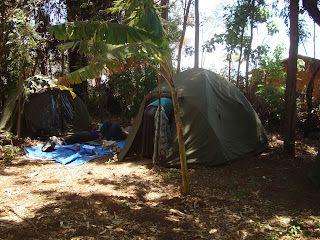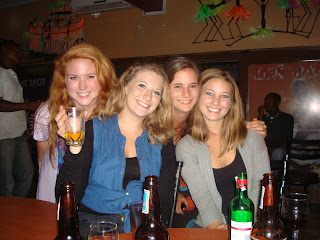Well
I’ve been home for over a month now, so I guess it’s about time to wrap things
up. I arrived at the Albany airport at approximately 6:30pm on December 16th,
and was welcomed home by my mom, my sisters (who had made a beautiful poster
for my homecoming), and a sick boyfriend. My journey home consisted of
unsuccessful attempts to sleep and reflection on my African adventure. I
suffered from home-sickness quite a lot at the beginning of my trip, but by the
end I didn’t want to leave just yet (although I did want to be home).
Something
I haven’t talked about in this blog is my thesis, which was a big part of the
reason I chose to travel to Tanzania in the first place. I’m pretty sure
nothing goes according to plan in Tanzania, and so it was with my thesis. In
the beginning I had hoped that I would be able to get my hands on some clinical
data under the impression that, compared to the US, Tanzanian privacy laws would
be pretty lax. Unfortunately (or fortunately, depending on how you look at it)
hospitals and clinics were more protective of their HIV patients than I
expected, so I took a different approach.
Luckily
for me I am writing a paper for the human biology department, which spans a lot
more than just the physical human body. After running into several road blocks,
I decided to research the interactions between culture, nutrition, and HIV
through personal interviews with various local health professionals. At this
point I had already conducted some baseline research using online WHO data that
supported my original hypothesis that malnutrition is increasing HIV mortality
rates in Tanzania. My next question was: Why? I formed my next hypothesis after
a few weeks of observing the culture and casually discussing the issue with
local Tanzanians. From here I decided to delve deeper into three main factors
contributing to malnutrition in the Arusha region: cultural tradition, lack of
knowledge, and gender inequality.
I
conducted five interviews in which I asked questions about these topics. I
spoke with an HIV/Nutrition educator, a retired physician who now works as a
home-based care provider for people living with HIV/AIDS, a nutritionist, a
nurse in the HIV unit of a local hospital, and the director of a women’s
outreach program. All of these individuals focused on different factors that
they felt were most influential to Tanzanian diets. Here are some of my
conclusions:
Cultural Tradition: As I’ve mentioned,
much of the Arusha region consists of Maasai and Maasai descendants. Maasai are
traditionally pastoralists, raising mainly goat and cattle, and therefore have a
diet rich in meat and milk. Green vegetables are rarely eaten and are actually
referred to collectively as “grasses”, causing widespread vitamin/mineral
deficiencies. The exclusive reservation of fruits for the young and the sick
further contributes to these deficiencies. Because a large majority of Tanzanians
who have HIV have never been tested, they continue to neglect these vital food
groups causing the immune system to deteriorate quickly as the virus attacks
the weakened immune system.
Lack of Knowledge: National studies
have been conducted testing knowledge of both nutrition and HIV. The results
show that knowledge levels are not up to par, hence GSC’s continued trainings. At
a more local level, pre- and post-tests are administered to every adult group
participating in the HIV/nutrition training. Although these trainings are
successful in raising awareness of HIV and nutrition, it is alarming to see how
little so many people know about these important topics before GSC intervenes.
Nutrition education particularly is something we don’t often think about in
America since the food pyramid and eating healthy is stressed at such a young
age in our education systems. Knowing a balanced diet is the first step to good
nutrition, and I was happy to hear that nutrition is one of the first topics of
conversation after an HIV diagnosis. However, I have learned that even with
this knowledge a desire to eat healthy and access to each food group are
separate obstacles that make solving the problem of knowledge look easy. Here
we come back to culture which has a huge impact on the desire to eat healthy. How
can a man eat less meat and more fruit if it’s going to take away from his
manhood? The mention of culture change scares these people, and many claim they
would rather die than change. Unfortunately that is a very real possibility.
Gender Inequality: I know I’ve talked
about gender inequality on here before, well surprise, surprise! It affects HIV
and nutrition. Women are naturally put at a higher risk for HIV than man due to
the “larger surface area of the vagina and cervix compared to the areas of the
penis where transmission can happen (foreskin, urethra and small tears on the
head),” (http://www.catie.ca/fact-sheets/epidemiology/women-and-biology-hiv-transmission).
Additionally, social conditions give women (especially in rural villages) little
control over their sexuality, including condom-use. People living with HIV/AIDS
are put at risk for malnutrition since they require increased dietary intake
and as the disease progresses they may become too physically exhausted to work
(thereby losing income to buy adequate amounts of food). Many of those
interviewed stated that women were also put at risk for malnutrition because
men are more highly valued in society and therefore their dietary needs are
prioritized by the family. Interestingly enough, the only interviewee who said
that diets between men and women are not generally different was a man. I’ll
have to do more background information to get a better idea of what’s really
going on.
And that's the exciting conclusion to my Afrian Adventure!! KWAHERI!
































